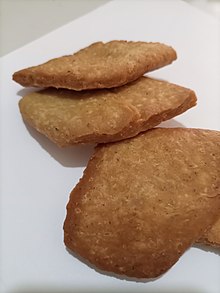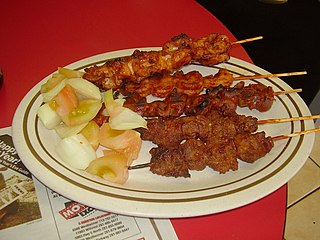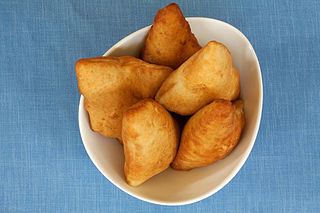 | |
| Course | Snack |
|---|---|
| Place of origin | Ghana |
| Serving temperature | Hot/Cold |
| Main ingredients | Flour, Desiccated coconut, Water, Salt,Sugar, Vegetable Oil |
Poloo is a Ghanaian snack which is referred to as fried coconut dough or fried biscuit. [1] [2]
 | |
| Course | Snack |
|---|---|
| Place of origin | Ghana |
| Serving temperature | Hot/Cold |
| Main ingredients | Flour, Desiccated coconut, Water, Salt,Sugar, Vegetable Oil |
Poloo is a Ghanaian snack which is referred to as fried coconut dough or fried biscuit. [1] [2]
Ingredients used in preparation. [3]
The process used in the preparation of Poloo. [3] [4]

Cooking bananas are banana cultivars in the genus Musa whose fruits are generally used in cooking. They may be eaten ripe or unripe and are generally starchy. Many cooking bananas are referred to as plantains or green bananas, although not all of them are true plantains. Bananas are treated as a starchy fruit with a relatively neutral flavour and soft texture when cooked. Bananas fruit all year round, making them a reliable all-season staple food.

Sri Lankan cuisine is known for its particular combinations of herbs, spices, fish, vegetables, rices, and fruits. The cuisine is highly centered around many varieties of rice, as well as coconut which is an ubiquitous plant throughout the country. Seafood also plays a significant role in the cuisine, be it fresh fish or preserved fish. As a country that was a hub in the historic oceanic silk road, contact with foreign traders brought new food items and cultural influences in addition to the local traditions of the country's ethnic groups, all of which have helped shape Sri Lankan cuisine. Influences from Indian, Indonesian and Dutch cuisines are most evident with Sri Lankan cuisine sharing close ties to other neighbouring South and Southeast Asian cuisines.

In West Africa, garri refers to the creamy granular flour obtained by processing the starchy tuberous roots of freshly harvested cassava.

Appam is a type of pancake, originating from South India, made with fermented rice batter and coconut milk, common in Kerala, Sri Lanka, Tamil Nadu. It is eaten most frequently for breakfast or dinner.

Ghanaian cuisine is the cuisine of the Ghanaian people. Ghanaian main dishes are organized around a starchy staple food, which goes with a sauce or soup containing a protein source. The main ingredients for the vast majority of soups and stews are tomatoes, hot peppers and onions. As a result, nearly all Ghanaian soups and stews are red or orange in appearance.

Kue is an Indonesian bite-sized snack or dessert food. Kue is a fairly broad term in Indonesian to describe a wide variety of snacks; cakes, cookies, fritters, pies, scones, and patisserie. Kue are made from a variety of ingredients in various forms, some are steamed, fried or baked. Kue are popular snacks in Indonesia, which has the largest variety of kue. Because of the countries' historical colonial ties, Koeé (kue) is also popular in the Netherlands.

Pithas are a variety of food similar to pancakes, dumplings or fritters, originating from the Indian subcontinent, common in Bangladesh and India. Pitha can be sweet or savoury, and usually made from a dough or batter, which is then steamed, fried or griddled. Very few varieties are oven-baked or boiled, and most are unleavened and cooked on a stovetop. Some versions may have a filling, garnish, or sauce. Few may be set or shaped after cooking. They are typically eaten as a snack with chai, or as treats during special occasions.
Chè trôi nước is a Vietnamese dessert made of glutinous rice filled with mung bean paste bathed in a sweet clear or brown syrup made of water, sugar, and grated ginger root. It is generally warmed before eating and garnished with sesame seeds and coconut milk. It is often served during Lunar New Year or more recently, served in the Cold-Eating Festival.

Nigerian cuisine consists of dishes or food items from the hundreds of ethnic groups that comprise Nigeria. Like other West African cuisines, it uses spices and herbs with palm or groundnut oil to create deeply flavored sauces and soups.

Javanese cuisine is the cuisine of Javanese people, a major ethnic group in Indonesia, more precisely the province of Central Java, Yogyakarta and East Java.

Boortsog or bawïrsaq is a type of fried dough food found in the cuisines of Central Asia, Idel-Ural, Mongolia and the Middle East. It is shaped into either triangles or sometimes spheres. The dough consists of flour, yeast, milk, eggs, margarine, salt, sugar, and fat. Tajik boortsog are often decorated with a criss-cross pattern by pressing the bottom of a small strainer on the dough before it is fried.

Puff-puff, as it is called in Nigeria and Sierra Leone, sometimes Ghana, and in anglophone Cameroon, is a traditional African snack made of fried dough. Other names for the food include buffloaf in Ghana, bofloto in the Ivory Coast, mikate in Congo, micate or bolinho in Angola, beignet in Francophone Cameroon, ligemat in Sudan, and kala in Liberia. The prominence of this delicacy stretches even to the eastern and southern edges of West Africa, where it is mostly known as mandazi.
A great variety of cassava-based dishes are consumed in the regions where cassava is cultivated, and they include many national or ethnic specialities.

Mandazi, is a form of fried bread that originated on the Swahili Coast. It is also known as bofrot or puff puff in Western African countries such as Ghana and Nigeria. It is one of the principal dishes in the cuisine of the Swahili people who inhabit the Coastal Region of Kenya and Tanzania. The dish is popular in the region, as it is convenient to make, can be eaten with almost any food or dips or just as a snack by itself, and can be saved and reheated for later consumption.

Sundanese cuisine is the cuisine of the Sundanese people of West Java, and Banten, Indonesia. It is one of the most popular foods in Indonesia. Sundanese food is characterised by its freshness; the famous lalab eaten with sambal and also karedok demonstrate the Sundanese fondness for fresh raw vegetables. Unlike the rich and spicy taste, infused with coconut milk and curry of Minangkabau cuisine, the Sundanese cuisine displays the simple and clear taste; ranged from savoury salty, fresh sourness, mild sweetness, to hot and spicy.

Arisa Pitha is a traditional sweet pancake from Odisha, India. The crispy outer layer surrounds soft insides.

Malaysian Indian cuisine, or the cooking of the ethnic Indian communities in Malaysia consists of adaptations of authentic dishes from India, as well as original creations inspired by the diverse food culture of Malaysia. Because the vast majority of Malaysia's Indian community are of South Indian descent, and are mostly ethnic Tamils who are descendants of immigrants from a historical region which consists of the modern Indian state of Tamil Nadu and Sri Lanka's Northern Province, much of Malaysian Indian cuisine is predominantly South Indian inspired in character and taste. A typical Malaysian Indian dish is likely to be redolent with curry leaves, whole and powdered spice, and contains fresh coconut in various forms. Ghee is still widely used for cooking, although vegetable oils and refined palm oils are now commonplace in home kitchens. Before a meal it is customary to wash hands as cutlery is often not used while eating, with the exception of a serving spoon for each respective dish.

Hausa koko also known as spicy millet porridge, is a Ghanaian street food commonly eaten as breakfast meal. It can also be taken in late afternoon as snack. It is made from millet with a few local spices added to give it a particular taste and color. It is called Hausa koko because of the notion it was created in the Northern areas of Ghana. It is also common in the various communities in Ghana.

Ayigbe biscuit is a Ghanaian snack created by Yonunawo Kwami Edze from Agbozume in the Volta Region.

Agbeli Kaklo is a Ghanaian snack made from cassava and eaten by the locals, the snack originated from the southern part of the Volta Region. It is very crunchy and mostly eaten with hard coconut. The snack is named as such because it is derived from cassava.